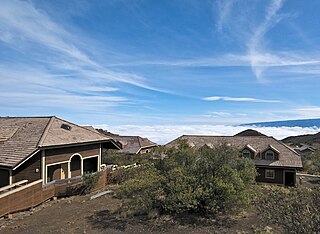
The Adler Planetarium is a public museum dedicated to the study of astronomy and astrophysics. It was founded in 1930 by Chicago business leader Max Adler. It is located on the northeast tip of Northerly Island at the shore of Lake Michigan in Chicago, Illinois. The Adler was the first planetarium in the United States and is part of Chicago's Museum Campus, which includes the John G. Shedd Aquarium and The Field Museum. The Adler's mission is to inspire exploration and understanding of the universe.

Boyden Observatory is an astronomical research observatory and science education centre located in Maselspoort, 20 kilometres (12 mi) north-east of the city of Bloemfontein in Free State, South Africa. The observatory is managed by the Physics Department of the University of the Free State (UFS). The Friends of Boyden assist the observatory as a public support group, organising open evenings and protecting its public interest. Boyden also makes use of members of ASSA Bloemfontein Centre, the amateur astronomy club of the city, for presenters and telescope assistants.

Stardome Observatory is a public astronomical observatory situated in Maungakiekie/One Tree Hill Domain in New Zealand's largest city, Auckland.

Griffith Observatory is an observatory in Los Angeles, California on the south-facing slope of Mount Hollywood in Griffith Park. It commands a view of the Los Angeles Basin including Downtown Los Angeles to the southeast, Hollywood to the south, and the Pacific Ocean to the southwest. The observatory is a popular tourist attraction with a close view of the Hollywood Sign and an extensive array of space and science-related displays. It is named after its benefactor, Griffith J. Griffith. Admission has been free since the observatory's opening in 1935, in accordance with the benefactor's will.

The Fleet Science Center is a science museum and planetarium in Balboa Park, located in San Diego, California. It is at the east end of the El Prado Drive walkway, next to the Bea Evenson Fountain and plaza in central Balboa Park.

Telus World of Science Edmonton (TWOSE) is a broad-based science centre in Edmonton, Alberta, Canada, operated by the (non-profit) Edmonton Space & Science Foundation. The centre is located on the southwest corner of Coronation Park in the neighborhood of Woodcroft. It is currently a member of both the Association of Science-Technology Centers (ASTC) and the Canadian Association of Science Centres (CASC).

The Sir Thomas Brisbane Planetarium is located on the grounds of the Brisbane Botanic Gardens in the suburb of Mount Coot-tha, Brisbane, Queensland, Australia. The Planetarium was officially opened on 24 May 1978.

Holcomb Observatory and Planetarium is a part of Butler University in Indianapolis, Indiana.

The National Planetarium is the national planetarium of Malaysia. It is a blue-domed structure that is situated on top of a hill in the Lake Gardens at Jalan Perdana, Kuala Lumpur. It is about 120,000 square feet (11,000 m2) in area.

The Mills Observatory in Dundee, Scotland, is the first purpose-built public astronomical observatory in the UK. Built in 1935, the observatory is classically styled in sandstone and has a distinctive 7 m dome, which houses a Victorian refracting telescope, a small planetarium, and display areas. The dome is one of two made from papier-mâché to survive in the UK, the other being at the Godlee Observatory.
The Science and Technology Education Innovation Center, formerly known as the Science Center of Pinellas County, is an educational center in St. Petersburg, Florida, United States. It occupies 7 acres (28,000 m2) of land located on 22nd Avenue North, in West St. Petersburg, located near the Tyrone Mall.

The South Florida Science Center and Aquarium (SFSCA) is located at 4801 Dreher Trail North, West Palm Beach, Florida, USA. Founded in 1959, the goal of the organization is to open every mind to science through the strategic programming of interactive exhibits and engaging community-based camps and events. The SFSCA has expanded since its creation and now houses over 50 hands-on exhibits, a planetarium, a 3000 square foot aquarium, a miniature golf course, and a large exhibit space that displays a temporary travelling exhibit. The SFSCA is a member of the ASTC program, which offers a membership that is redeemable at other ASTC science and technology centers around the world. The SFSCA occupies Dreher Park alongside the Palm Beach Zoo and offers deals for entrance to both facilities. The phone number for the South Florida Science Center and Aquarium is (561) 832-1988.
Bryan-Gooding Planetarium in the Alexander Brest Science Theatre is a planetarium in the Museum of Science and History in Jacksonville, Florida, U.S. It was built in 1988 and featured a 60-foot-diameter (18 m) dome-shaped projection screen, JBL stereo sound system, and a Zeiss Jena Optical mechanical planetarium star projector. The facility has seating for 200, and approximately 60,000 people see a planetarium show each year.

The Astronaut Memorial Planetarium and Observatory, or AMPO, also known as the Eastern Florida State College Planetarium and Observatory, is an astronomical observatory and planetarium at Eastern Florida State College in Cocoa, Florida. The facility consists of a planetarium, public observatory, large-screen movie theater, exhibit halls, multi-media classroom and an art gallery.

The Orchard Hill Observatory is an astronomical observatory located at the highest point on the University of Massachusetts Amherst campus. Constructed in 1965, the observatory is a red brick building with a 16-inch Cassegrain reflector optical telescope. It is used for several community events and is regularly open for public viewing on Thursday nights. Originally the observatory was home to a 20” telescope, given to the department by an avid amateur who lived in central Massachusetts. It was a 1/10 scale model (loosely) of a larger 200” scope. Eventually, a crack was spotted during one of the re-aluminizings of the 20” mirror and the scope was no more. In the meantime, the department had been granted money associated with its move from Hasbrouck to the Grad Research Tower to buy a small telescope and put in on top of the GRC. The GRC had a small "isolation" pad built on its roof, which was supposed to be a mount for the scope, which could be accessed via a small open elevator. However, the GRC had terrible noise and gross vibration problems. The isolation pad never worked and there were too many safety concerns about using the roof of the building for observing. A 16" telescope was later bought from Competition Associates. That scope arrived in 1976 but because of the problems with using the top of the GRC, the scope was never mounted there. In fact, it sat in the basement of Hasbrouck for perhaps 10 years, becoming known as the "Subterranean Telescope.” This situation finally led to the 20" being disassembled and the 16" scope being moved to Orchard Hill and installed in the dome there. The 16" was a major improvement in usability. As to what happened to the 20", the mirror may have been stored in the Astronomy Research Facility but the drive was most likely not kept.

The Museum of Science and the Cosmos, is an astronomy, technology, and science museum located in the city of San Cristóbal de La Laguna on Tenerife island, in the Spanish Canary Islands of Macaronesia. It belongs to the Cabildo de Tenerife and the Tenerife Organization of Museums and Centers. The museum opened in 1993 under the initiative of the Cabildo and the Instituto de Astrofisica de Canarias (IAC). It is considered the primary astronomy and science museum of the Canary Islands and the Macaronesian archipelago.

The Onizuka Center for International Astronomy, also known as Hale Pōhaku, is a complex of support facilities for the telescopes and other instruments that comprise the Mauna Kea Observatory atop Mauna Kea, on Hawaiʻi island.

The Santa Fe College Kika Silva Pla Planetarium is a 34-foot in diameter, domed theater in Gainesville, Florida. The planetarium seats 60 people and uses two projection systems. An In-Space-System (ISS) 1C-3K digital projection system by RSA Cosmos and an optical-mechanical Chronos Space Simulator manufactured by Goto.

Eastern Florida State College, formerly Brevard Community College, is a public college in Brevard County, Florida. It is a member of the Florida College System and has campuses in Cocoa, Melbourne, Palm Bay, and Titusville, as well as a Virtual Campus. EFSC is a direct connect satellite campus program to The University of Central Florida (UCF) in Orlando, Florida.

The Class of 1951 Observatory is located near the eastern edge of the town of Poughkeepsie, New York, on Vassar College's campus.





















